DFID Gender Pay Gap Report 2019
Published 23 January 2020
Introduction
The Department for International Development (DFID) leads the UK’s work to end extreme poverty, building a safer, healthier, more prosperous world for all of us which is firmly in the UK’s national interest. We are ending the need for aid by creating jobs, unlocking the potential of girls and women, and helping to save lives when humanitarian emergencies hit.
DFID has over 3000 staff with head offices in London and East Kilbride (near Glasgow) and substantial teams in more than 30 countries across Africa, Asia and the Middle East. Our pay approach is designed to support fair treatment and reward all our staff regardless of gender. We are committed to being an inclusive employer by offering opportunities that will help staff realise their full potential and recognise their contribution to DFID’s, and the wider UK Government’s, ambitions. Building a diverse and inclusive workforce that reflects the people we serve is one of the Civil Service’s top workforce priorities. Our collective aim is to make the Civil Service the UK’s most inclusive employer by 2020. Our People Plan outlines how we plan to achieve this. The Civil Service should create opportunities for all in a truly meritocratic way and reward all civil servants fairly, regardless of gender, ethnicity or any other personal characteristic.
In 2017, the Government introduced world-leading legislation that made it statutory for organisations with 250 or more employees to report annually on their gender pay gap. Government departments are covered by the Equality Act 2010 (Specific Duties and Public Authorities) Regulations 2017 which came into force on 31 March 2017. These regulations underpin the Public Sector Equality Duty and require the relevant organisations to publish their gender pay gap data by 30 March annually. This includes the mean and median gender pay gaps; the mean and median gender bonus gaps; the proportion of men and women who received bonuses; and the proportions of male and female employees in each pay quartile.
The gender pay gap shows the difference in the average pay between all men and women in a workforce. If a workforce has a particularly high gender pay gap, this can indicate there may be a number of issues to deal with, and the individual calculations may help to identify what those issues are.
The gender pay gap is different to equal pay. Equal pay deals with the pay differences between men and women who carry out the same jobs, similar jobs or work of equal value. It is unlawful to pay people unequally because they are a man or a woman. Under Gender Pay Gap reporting, we are required to report on the difference between men and women who work in DFID in relation to:
- mean hourly rate of pay
- median hourly rate of pay
- mean bonus paid
- median bonus paid
The proportions of:
- men and women who were paid a bonus
- men and women in the 1st (lower) quartile, 2nd, 3rd, and 4th (upper) quartile pay bands
Definitions
The Regulations require information to be reported under the following definitions.
The mean average is calculated by adding together all the values and dividing by the number of values. In this case a mean average is calculated for men, a mean average is calculated for women, and the 2 mean averages are compared.
The median average is calculated by sorting the values into an order from lowest to highest, and then finding the value that is in the middle of that sorted list. In this case a median average is calculated for men, a median average is calculated for women, and the 2 median averages are compared.
The pay quartiles are based on hourly pay for all staff. They are sorted into order from lowest amount to highest amount. This ordered list is then split into 4 equal parts, known as quartiles. The lowest pay quartile contains the first quarter of the ordered list, i.e. the 25% of the list with the lowest hourly rates of pay. The upper quartile contains the 25% of staff whose hourly rates of pay are the highest. Quartiles are related to the median average, as the median average marks the point between the second and third quartile.
Please note that throughout the report, due to rounding the total may not equate to an exact sum of the figures.
Statement
DFID confirms that our data has been calculated according to the requirements of the Equality Act 2010 (Specific Duties and Public Authorities) Regulations 2017.
Locally engaged staff who are contracted outside of the UK are not covered by the definition of employee for the purpose of Gender Pay Gap reporting and are not included in the calculations.
Pay data used for this report is based on employee pay on the snapshot date of 31 March 2019 (including bonuses paid at 31 March 2019) and bonus pay for the period 1 April 2018 to 31 March 2019.
Gender pay gap and bonus pay
DFID’s median pay gap fell to 8.4% in 2018/19, down 0.7 percentage points from 9.1% in 2017/18. DFID’s overall mean gender pay gap for the organisation rose slightly from 6.9% in 2017-18 to 7.2% in 2018-19, following a fall from 8.5% to 6.9% between 2016/17 and 2017/18. We have seen a decrease in the mean pay gap within SCS from 8.6% down to 0% over the last 3 years. Within other grades the mean gender pay gap has fluctuated between years.
Explaining our gender pay gap
As in previous years, DFID continues to have a high proportion of its roles in more senior managerial grades (SCS – A2). Women are represented at these grades at a lower proportion than the overall proportion of women in DFID.
Roles at higher grades are also more likely to be based in London or overseas whereas lower grades, where women are over-represented, are more likely to be based outside of London and therefore paid at the lower, national rate. These factors continue to be key drivers of DFID’s overall mean and median gender pay gaps.
Profile of the workforce
This report contains information for 2,781 employees as at 31 March 2019 as required by the Gender Pay gap regulations. Of these, 2,670 were classed as ‘full pay relevant’ employees and are included in the mean and median Gender Pay Gap calculations. All employees are included in the bonus Gender Pay Gap calculations. This report does not include data for locally employed staff overseas, contractors or consultants.

Profile of the workforce: Male v Female
In 2018/19 women made up 56% of DFID’s workforce. Women make up 54% of the wider Civil Service so DFID is broadly similar[footnote 1]. There has been very little movement in the gender composition in the last year. There continues to be an almost equal split of men and women in DFID’s Senior Civil Servants, with 51 and 48 respectively.
Gender breakdown by grade
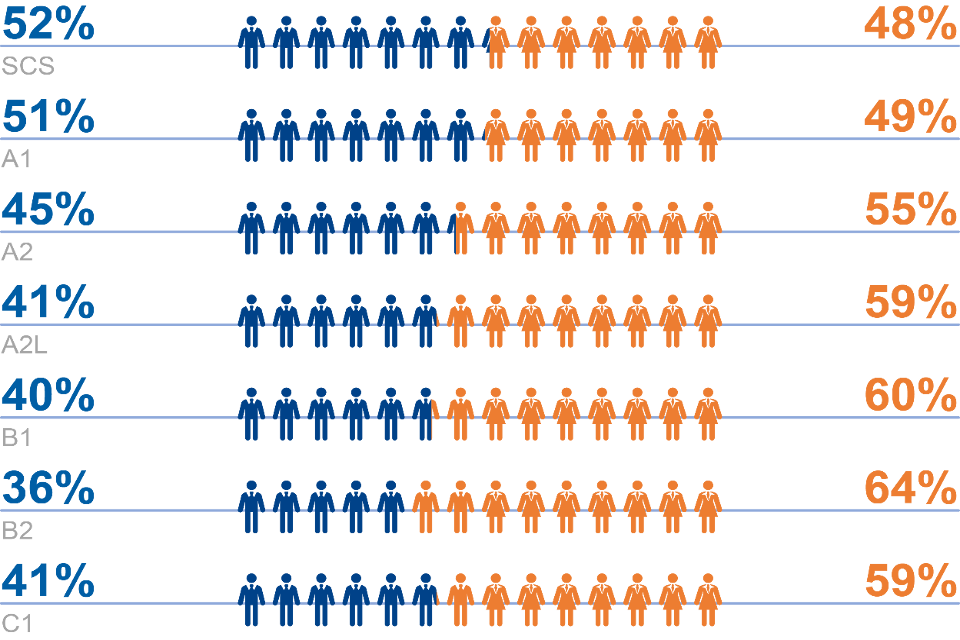
Gender breakdown by grade
| Grade | Number of men | % of total men | Men at grade | Number of women | % of total women | Women at grade | Mean pay gap | Median pay gap |
|---|---|---|---|---|---|---|---|---|
| SCS | 51 | 4% | 52% | 48 | 3% | 48% | 0.0% | -0.4% |
| A1 (Grade 6) | 253 | 22% | 51% | 247 | 17% | 49% | 3.2% | 3.7% |
| A2 (Grade 7) | 413 | 36% | 45% | 500 | 35% | 55% | 0.9% | 0% |
| A2L (SEO) | 116 | 10% | 41% | 167 | 12% | 59% | 2.2% | 3.1% |
| B1 (HEO) | 174 | 15% | 40% | 261 | 18% | 60% | 1.5% | 0% |
| B2 (EO) | 96 | 8% | 36% | 169 | 12% | 64% | 2.4 | 7.8% |
| C1 (AO) | 36 | 3% | 41% | 51 | 4% | 59% | -1.7 | 0% |
Note: This table does not contain any information about any talent programmes run by DFID due to small numbers of individuals. Only individuals who are in scope for gender pay gap reporting are included in this table. Figures may not match other reports where different employee groups have been used. Ministers are also excluded as they do not fit into the grade categories listed above.
Mean Grade Comparison 16/17 to 18/19
The mean gender pay gap in SCS grade has decreased significantly from 8.6% in 2016/17 and is now sitting at 0%. Within other pay grades it has fluctuated across years, however only grade A2L remains higher than 2016/17 level.
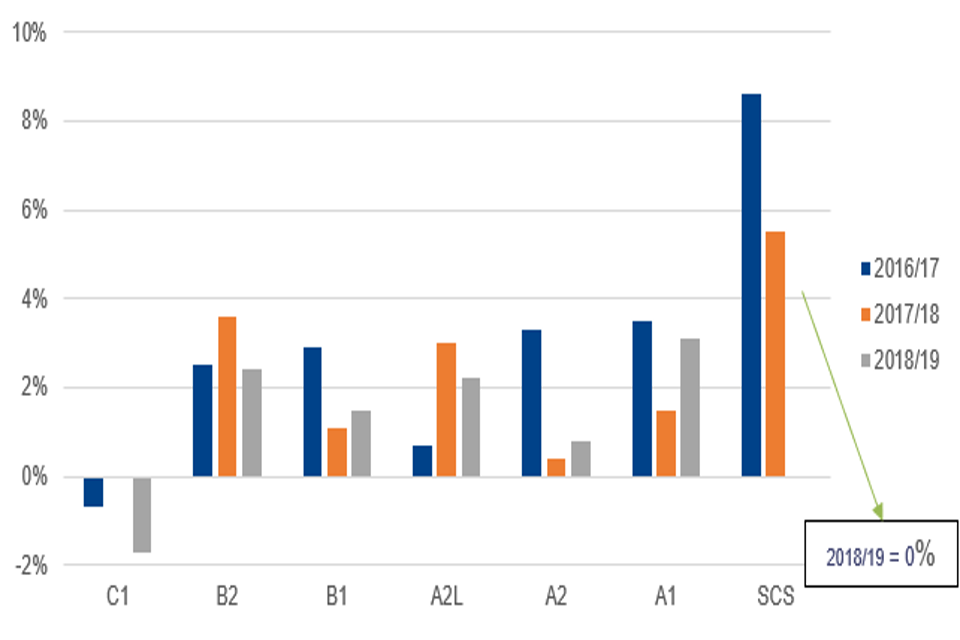
Mean grade comparison 16/ to 18/19
The mean gender pay gap within grades has fluctuated since 2016/17. In grades A1, A2 and B1, the mean pay gap decreased from 2016/17 to 2017/18, and subsequently increased this year; however, they remain lower than the 2016/17 levels. In other grades, we saw an increase in the mean GPG between 2016/17 and 2017/18, followed by a decrease this year. C1 is the only grade at which there is a negative mean pay gap, meaning that women have higher mean earnings than men.
Basic Pay
Basic pay in terms of the Gender Pay Gap Legislation for DFID is the basic salary and any specialist allowances (such as IT) that was paid in the relevant period of the snapshot data. The difference in hourly pay at 31 March 2019 between men and women is shown below.
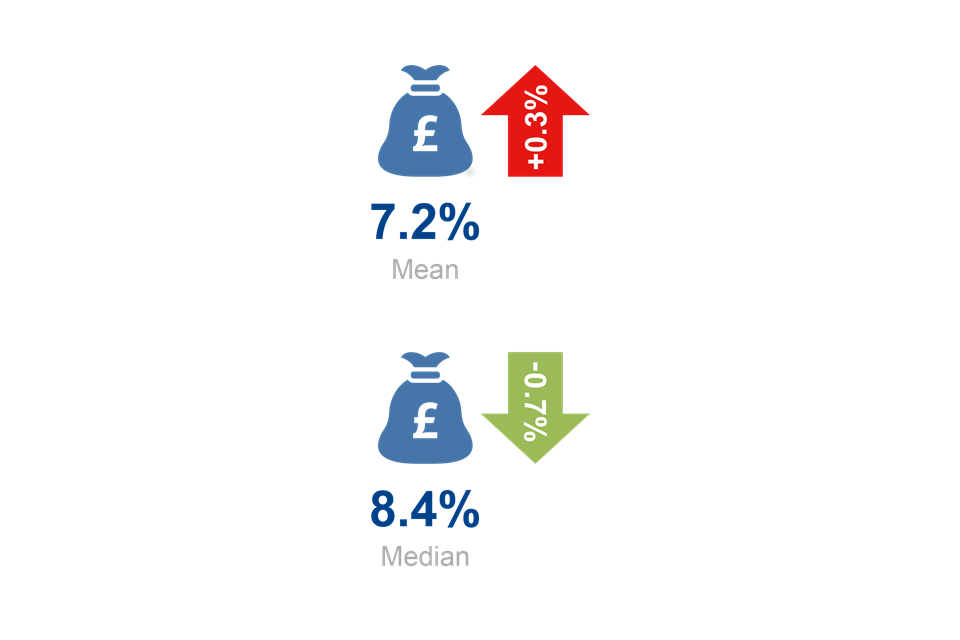
Basic pay
The mean hourly pay for men in DFID is 7.2% higher than the mean hourly pay for women. The median hourly pay for men is also higher, with men’s median hourly pay being 8.4% higher than the median hourly pay for women, coming down from 9.1% in 2017/18.
The mean pay gap has increased by 0.3 percentage points between 2017/18 and 2018/19. However, the median pay gap has decreased by 0.7 percentage points from 2017/18, to 8.4%. The salary for the median female has decreased from 2017/18, however the salary for the median male has also reduced.
Basic Pay - Gender Pay Gap
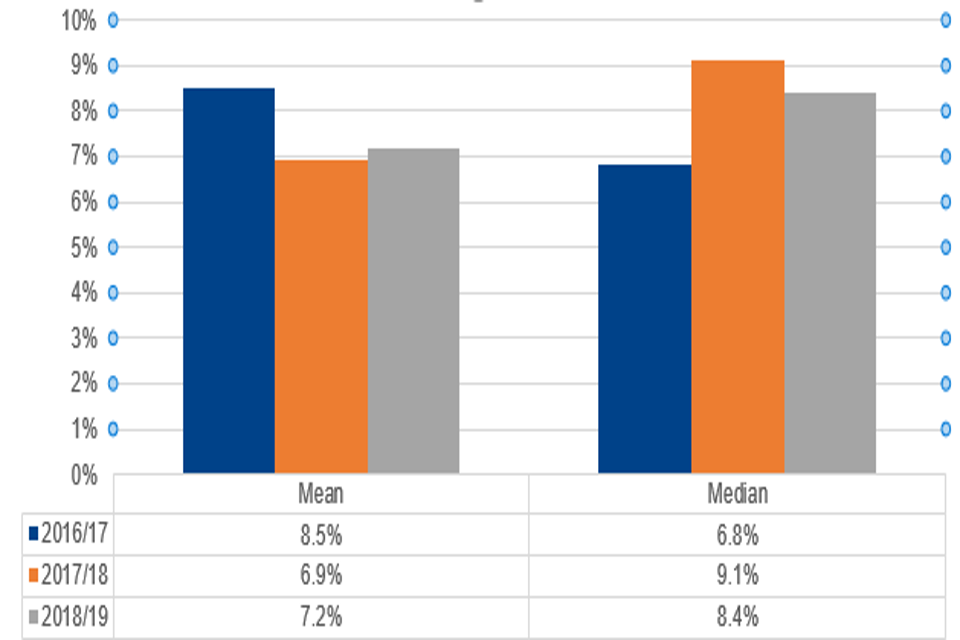
Basic pay - gender pay gap
Pay Quartiles
Sixty three percent of employees in the lowest pay quartile are women, compared with 49% of employees in the top pay quartile. As shown in the grade breakdown table on page 7 there are fewer women in the highest grades (SCS and A1) which is reflected in the gender split across pay quartiles. The table also shows a disproportionate number of women in the lower grades within the organisation.
The distribution of women across pay quartiles has seen little change since 2018; there has been a slight increase in the proportion of women in all quartiles (ranging from 0.5 – 1.4 percentage points), however this is broadly in line with the increase in the overall percentage of women in DFID since 2018 (0.8 percentage points).
Gender Pay Gap: Quartiles

Gender pay gap: quartiles
Bonus Pay
The difference in bonus pay between men and women for the period from 1 April 2018 to 31 March 2019 is shown below. This includes any recognition awards and in-year awards which were paid during this time period[footnote 2].
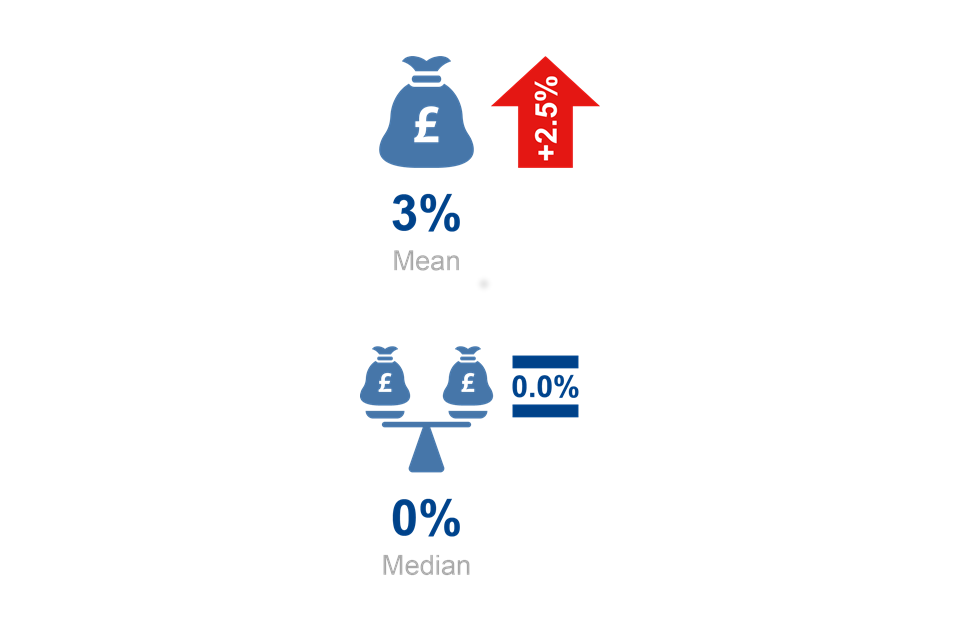
Bonus pay
In 2018/19, DFID had a mean bonus pay gap of 3%. There was no gap between median bonus pay for men and women in the organisation.
Bonus Pay - Gender Pay Gap

Bonus pay - gender pay gap
Percentage of bonuses paid
Over the 12 month period, 69.4% of women received a bonus, while 67.4% of men received one. This is an increase of 5.4 percentage points and 8.0 percentage points for women and men respectively, based on the calculations in the table below.

Percentage of bonus paid
Bonus Payments Proportions
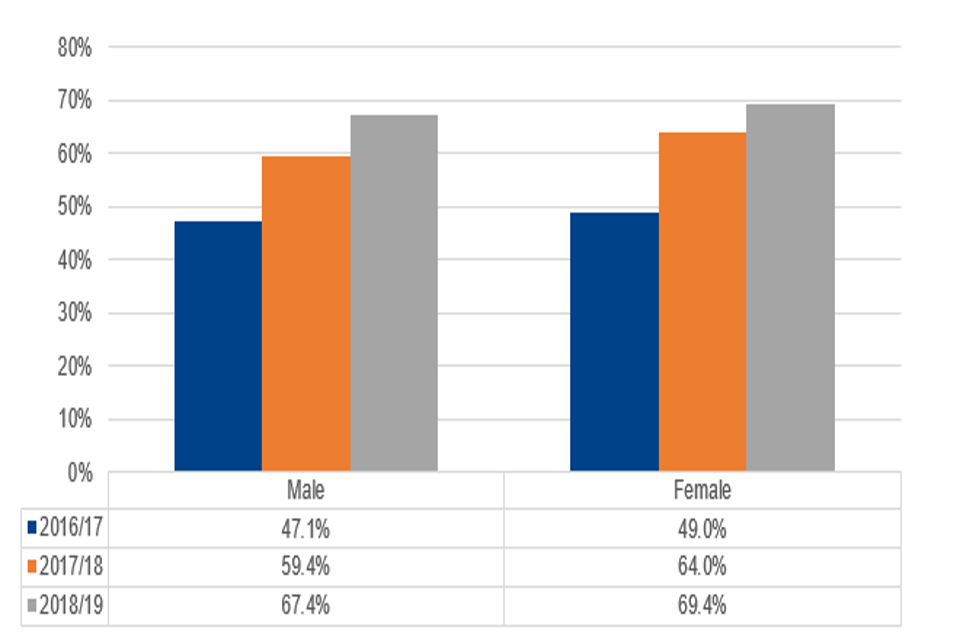
Bonus payments proportions
Note: We have identified a small error in the way the proportion of employees who received a bonus was calculated for previous years. The figures have been updated retrospectively in this publication.
Closing the gender pay gap
Over the last 3 years, between 2016-17 and 2018-19, our analysis continues to show that our gender pay gap is as a result of the gender balance across our grades, whereby women are represented at senior grades at a lower proportion than the overall proportion of women in DFID. By contrast, women are overrepresented at lower grades compared to men. We have been continuing to work to address these structural factors and have seen some positive outcomes, including our SCS mean gender pay gap reducing to 0%. However, we recognise that there is still more to do across the organisation.
At DFID, our senior leaders continue to be committed to closing our gender pay gap and see their role as championing this throughout the organisation. Our Permanent Secretary was acknowledged for his role in engaging, challenging and leading gender equality as a 2019 ‘Agent for Change’ by Management Today. This focus remains at the forefront of his leadership of DFID.
The launch of DFID’s 3 year People Plan in April 2019 provides both focus and coherence on the people agenda and integrates our commitments to the Civil Service Workforce Plan and Diversity & Inclusion Strategy. The Plan’s delivery is overseen by a new People and Operations Committee chaired by the Director General for Finance and Corporate Performance.
The plan has specific goals on values and inclusion; people management; building future capability, enhancing our employment offer; and flexible and smart working. All of these tackle both the structural and cultural issues that impact on inclusion, with the aim of making DFID a great place to work in which all our people can thrive. Everything we do is designed to consider the implications to all our staff, irrespective of gender or personal circumstances.
It is through this work on inclusion that we can have the most impact on the gender pay gap and the opportunities for women across the whole of the organisation.
Closing the gender pay gap is an integral part of our approach to Diversity and Inclusion. As our pay gap is largely a result of having proportionately more men than women at senior grades, and proportionately more women than men at lower grades, the most effective way of closing the gender pay gap is to work to close the gap between the grade distributions of men and women. The key elements of how we address this are:
Engagement
DFID has recognised that engaging with a wide range of staff and external organisations is fundamental to addressing the gender pay gap. The introduction in 2018 of the Gender Pay Gap working group has allowed us to broaden the discussion and share lived experiences relating to factors that may influence the gender pay gap (e.g. promotions, returns to work, career breaks).
Recruitment
We aim to recruit a talented and diverse workforce which reflects the society we serve. Our recruitment approach recognises the need to minimise the barriers to women progressing and developing in their careers.
As a result of this, when advertising roles we ensure anonymous recruitment is in operation for grades A1 and below.
We also have a policy of no single-sex interview panels at all grades, as well as promoting diverse panels at all grades as standard. Interviews for all roles are conducted in a structured manner, with all candidates asked the same predetermined questions and graded using standardised criteria, which helps reduce the risk of unfair bias influencing decisions.
Vacancies must be advertised as equally available to full time, flexible, and job share working patterns and must not be restricted unless there is a strong business rationale for why this cannot be accommodated. Vacancy holders must consider any requests for alternative working patterns in order to attract and retain candidates that require flexible working.
From January 2019, DFID has implemented Success Profiles as our standard framework for recruitment. In introducing this framework, the intention has been to make our recruitment process more accessible, helping us improve attraction and diversity and inclusion. Candidates are assessed against a variety of elements of the framework, using a range of different selection methods.
Progression
DFID has already seen positive progression in more women taking up senior roles especially in SCS grades; 48% of our SCS are women, up from 31% 11 years ago.
DFID continues to work to remove barriers to career progression for all talented staff under-represented in our senior grades by encouraging participation in Civil Service Talent Programmes including the Positive Action Pathway and Future Leaders Scheme for staff at grade A1 and below, where the intake for DFID’s 2019 cohort was 67% female.
Mentoring and coaching are available to all staff through the matching service provided by Civil Service Learning, allowing staff to personalise their development to their own level and speed of progression as required. We are also increasing our support on key leadership transitions, to help people both plan and manage taking up and enacting more senior roles.
As part of our People Plan we are also reviewing how we use talent schemes, with the intention of focusing them more explicitly on identified medium to long-term workforce and succession risks, and on improving the diversity of our talent pipelines.
Overall, our analysis shows that women secure at least a proportional share of promotions.
Career Paths
In addition to development programmes for existing employees, DFID also offers apprenticeships and internships to provide access to opportunities, stretch and networks for individuals to reach their potential.
DFID staff within the UK have access to flexible working arrangements, supporting work-life balance. Our People Plan commits us to rolling out the principles of flexible working to our overseas offices over the next year. This allows our staff opportunities to better balance their careers and wider responsibilities and interests. As an example of our ambition to maximise inclusion in our workforce, we have worked with networks to highlight the opportunity of Shared Parental Leave; the uptake within DFID almost doubled from 9 to 17 in 2017/18 and remained steady at the same figure in 2018/19. Our Shared Parental Pay mirrors our Maternity Pay arrangements.
People management capability
A core part of our new People Plan is to improve line management performance, and support to managers in building team effectiveness and resilience. Inclusive management principles, behaviours and capabilities will be central to this effort. The goal is to ensure managers reflect on their own bias, and invest in understanding and optimising the different strengths, perspectives and potential of all their staff. Our new approach to performance management, Being my Best, also focuses on inclusive and strengths-based people management, and continuous performance improvement and learning.
Pay Policy
Our approach is aimed at continuing to find ways in which to address the pay disparities through ongoing development of people policies and our wider pay strategy.
GPG is a key focus in DFID’s employment offer as part of our broader People Plan over the next few years.
DFID’s Networks and Trade Unions
DFID has a range of 14 staff networks which continue to play a vital role in delivering workplace inclusion for all our employees. The value of the networks is recognised in DFID and we encourage those who play key roles in networks to include this as part of their performance objectives.
An example is the women’s network, whose overall objective is to support and inspire women at all levels in DFID to achieve their potential. Its work focuses on a number of activities, such as:
- inspiring women - through events, external speakers, workshops and seminars
- building confidence - through networking, mentoring and learning from others
- empowering women - overcoming barriers to success and engaging on key issues that affect them
DFID is working with its Trade Unions, PCS and FDA, to develop a coherent approach to our short and longer term Pay and Reward strategy.
Going Forward
We expect our actions outlined in the People Plan will enable us to continue to make progress in closing our gender pay gap over the next year. A key part of the policy refresh outlined in that plan is to ensure that our policies have a positive impact on our workforce, particularly in relation to diversity and inclusion.
DFID is at the forefront of the UK Government’s ‘way we work’ programme to transform how we think about work, and how and where we do it. Investment in new IT and technology will enable us to work more flexibly, and Smarter Working is also embedded as an integral part of our People Plan.
Additional Information
Clarification of Grades:
DFID uses the Civil Service grade structure using the following names:
- A1 – Grade 6
- A2 – Grade 7
- A2L – Senior Executive Officer
- B1 – Higher Executive Officer
- B2 – Executive Officer
- C1 – Admin Officer
Regulations
For further information on the Gender Pay Gap including definitions of in-scope employees, please consult the statutory regulations: The Equality Act 2010 (Specific Duties and Public Authorities) Regulations 2017.
The Department for International Development: leading the UK government’s fight against world poverty.
Department for International Development
22 Whitehall
London
SW1A 2EG
UK
and at:
Abercrombie House
Eaglesham Road
East Kilbride
Glasgow
G75 8EA
UK
Tel: +44 (0)20 7023 0000
Fax: +44 (0)20 7023 0016
Facebook: www.facebook.com/ukdfid
Twitter: @DFID_UK
Email: enquiry@dfid.gov.uk
Public enquiry point: 0845 3004100 or +44 1355 84 3132 (if you are calling from abroad).
© Crown copyright 2019
Copyright in the typographical arrangement and design rests with the Crown. This publication (excluding the logo) may be reproduced free of charge in any format or medium, provided that it is reproduced accurately and not used in a misleading context. The material must be acknowledged as Crown copyright with the title and source of the publication specified.
Published by the Department for International Development.
-
Civil Service Statistics at 31st March 2019 - Cabinet Office ONS Civil Service Workforce Data Report; 2018, pdf 333KB. The Cabinet Office report has different definitions for which employees are in scope. ↩
-
This includes awards recognising excellent performance and behaviour in delivering short, medium- and long-term goals to the organisation whilst demonstrating DFID and Civil Service values. These take the form of either monetary payments or recognition vouchers. Like other government departments we publish this information annually. ↩
